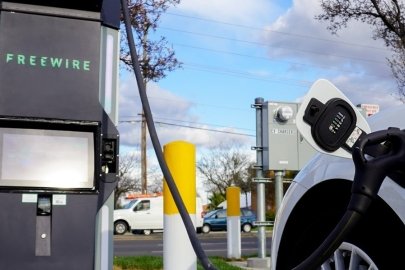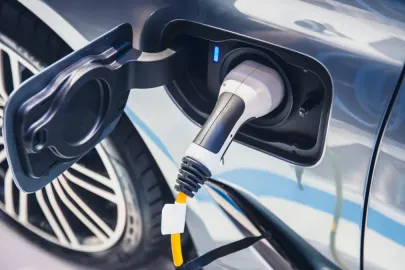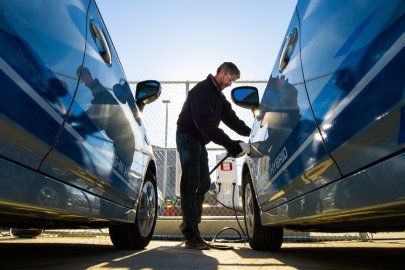If you’re not sure what to expect the first time you pull up to a public electric vehicle (EV) charging station, read on to understand the connectors, how to use the charging station, as well as how long it takes to charge, costs, and other considerations.
Quick Links
How Do I Use a Public Charging Station?
Charging an EV is easy, but there are some differences from filling your car with gasoline. Although it’s usually easiest to charge your EV at home, there may be times when you need to use a public charging station—and you almost certainly will if you’re driving a rental EV.
To use a public charging station, you should:
1. Locate a charging station.
Use the Alternative Fuels Data Center (AFDC) Station Locator ahead of time to plan your trip and map a route or on the go by downloading the mobile app. As you find stations in the Station Locator, make note of the charging networks they belong to.
You may want to download the charging network apps to authenticate and pay at DC fast-charging stations; visit the charging networks’ websites to learn how each one works.
2. Confirm you have compatible connectors.
Check the type of charger connector available at the station when planning your charging stops. These are the types of charging connectors you may find, with some charging ports offering more than one type of connector:
J1772 (left, without CCS connecter; right, with CCS connector) | CHAdeMO | J3400 (NACS) |
|---|---|---|
|
|
|
3. Connect to the charger.
Find which side of the vehicle your charging port is on, similar to where a fuel cap would be or on the front of the car. You may need to press a button to open the charging port.
Identify if your port has built-in charging cables or if you need to connect your own cable to the socket on the charging station. Although Tesla vehicles do not have a CCS or CHAdeMO charge port, they come with a limited CCS or CHAdeMO adapter that supports charging up to 19.2 kilowatts. Tesla does sell full power adapters for both connector types.
Most electric rental cars include charging cables, but you may have to look in the trunk or lift a cover to find it. Non-Tesla EVs can connect to certain Tesla charging stations when a Magic Dock adapter is available.
Once you have your plug and your port, you are ready to connect the two and start charging.
4. Start the charging session.
Pay directly at the charger with a credit or debit card, similar to a fueling station, or use a smartphone app from the charging network to authenticate the session and pay.
5. Monitor charging progress.
You can check the progress of your charging session via your vehicle’s dashboard, on the charging station, or in the mobile app, if you used one to start the session.
6. End the charging session.
End your session once your EV is charged to the level you want on the app or charging station. Unlock the cable via your vehicles dashboard and remove it from the charger.
Don’t forget to disconnect your cable, if you used your own, from the charging station and take it with you!
How Long Does It Take to Charge an Electric Vehicle?
The amount of time it takes to charge your EV depends on the vehicle and the type of charger, which come in three levels. The Station Locator notes which charger levels are available at each station, as well as the type of connectors.
If connecting an all-electric vehicle or plug-in hybrid EV (PHEV) to a Level 1 charging cable for long-term, at-home charging, consult a licensed electrician to ensure there is a dedicated circuit to support the power load. Read more about charging EVs at home.
| Level 1 Charging | Level 2 Charging | Level 3 Charging |
|---|---|---|
|
|
|
How Safe Is Charging an Electric Vehicle?
Although charging at home is generally safe, if you’re connecting to a level-1 charging cable for long-term charging, you may want to consult a licensed electrician to ensure there is a dedicated circuit to support the power load.
Do not use an extension cord to charge an all-electric vehicle or PHEV. EV chargers contain thicker wires that can handle more power than smaller gauge wires in typical extension cords. Using an extension cord increases the risk of fire, overheating, and electric shock.
A licensed electrician can also install a 240-volt electricity outlet for level-2 charging at home and ensure that any existing 240-volt outlets are safe for vehicle charging.
You should also consult an electrician if installing an in-home charging unit, which can be used to schedule vehicle charging. An electrician will check the safety of the 240-volt plugs and ensure that the proper unit is installed for the location (units differ for indoor and outdoor installations).
What Does It Cost to Charge an Electric Vehicle?
The cost to charge an electric vehicle depends on the cost of electricity and the efficiency of the vehicle—measured in how many kilowatt-hours it uses to travel 100 miles.
According to the Alternative Fuels Data Center, if electricity costs about $0.11 per kilowatt-hour, charging an EV with a 200-mile range (assuming a fully depleted 54 kWh battery) will cost about $6 to reach a full charge.
Use the Vehicle Cost Calculator to compare estimated operating costs for different vehicles.
EV charging equipment may be eligible for a tax credit.
Subscribe to receive updates from Energy Saver, including weekly tips, updated content, and seasonal energy saving guidance for consumers and homeowners.








